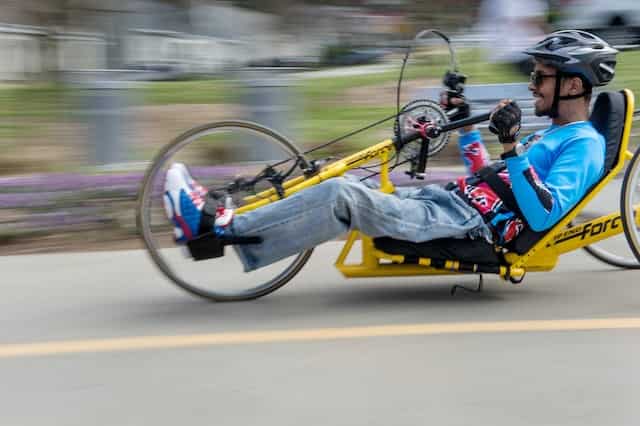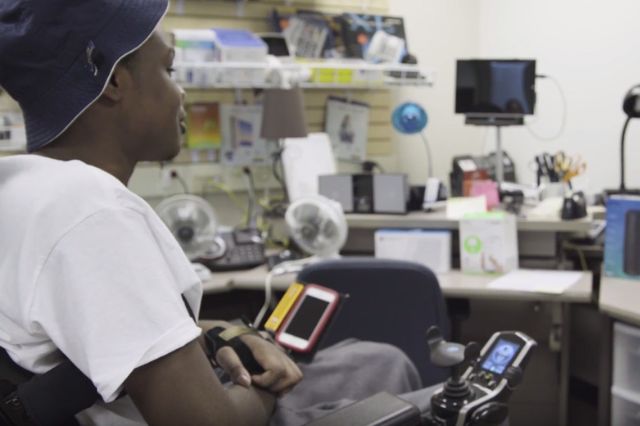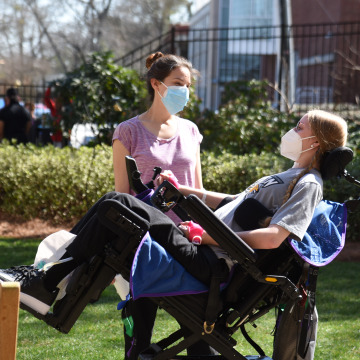Ventilator Management and Weaning Program
Our Experts Take a Comprehensive Approach to Ventilator Management and Weaning
After sustaining a traumatic brain injury or high-level spinal cord injury, it may be difficult for patients to breathe on their own. In such cases, a ventilator with or without a trach may be necessary to assist with breathing.
Shepherd Center's ventilator services program is led by an experienced and aggressive team of respiratory therapists and pulmonology/critical care physicians who work to wean patients off ventilators whenever possible to increase independence, activity, and comfort.
How does a ventilator work?
A ventilator is a device that supports or recreates the process of breathing by pumping air into the lungs. It has many settings and alarms tailored to each person's needs determined by the doctor. Some people need a ventilator all the time, while others only use it part of the time. It depends on the person’s needs and the doctor’s orders.
There are invasive and noninvasive methods to get air from the ventilator into your lungs. Noninvasive involves wearing a face or nasal mask to get air from the ventilator into your lungs. The face or nasal mask fits tightly over your nose and mouth to help you breathe. Your doctor may recommend this method if your breathing problems are not yet severe enough for you to need a trach tube or to help you get used to breathing on your own after your trach tube is removed.
How does a trach work?
When noninvasive ventilation is not enough, a tracheostomy, a small surgical opening, is made in the part of the throat called the trachea or windpipe. A tracheostomy tube is placed into the hole to keep it open for breathing, oxygenating, and/or ventilation.
What to Expect as a Ventilator/Trach Patient
Before we recommend ventilator weaning, our staff evaluates each patient's physical and psychological state.
Many patients with a spinal cord injury at the C-3 level or below have the potential to be weaned from the ventilator. Techniques such as biofeedback can be used in some instances to retrain the weakened muscles. The goal is to wean patients off the ventilator and also teach them how to live an active and productive life post-injury.
For patients who need to continue using a ventilator, Shepherd Center staff focuses on educating them on how to live an active lifestyle while the respiratory educator trains each patient and their family members in home care techniques and health management.
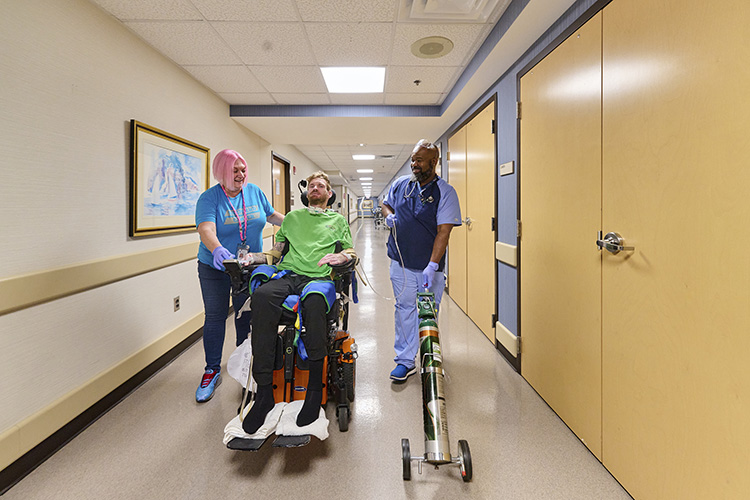
Ventilator and Trach Services
We offer comprehensive ventilator and trach services to suit the unique needs of our patients. Ventilatory support may include:
- CPAP (Continuous Positive Airway Pressure). A machine that uses mild air pressure to keep breathing airways open while you sleep.
- BiPAP (Bilevel Positive Airway Pressure). A form of noninvasive ventilation that uses positive air pressure to help you breathe.
- Nebulizer. A machine that delivers medication directly into the lungs.
- Inhalers. A handheld device that delivers medication directly to your lungs.
- Metaneb System. A single machine that combines lung expansion, secretion clearance, and aerosol delivery into a single integrated therapy session.
- Vest. An inflatable vest that is attached to a machine. The machine mechanically performs chest physical therapy by vibrating at a high frequency. The vest vibrates the chest to loosen and thin mucus.
- Ventilator. Also known as a breathing machine or respirator, a ventilator is a machine that helps you breathe by pushing air into the lungs.
- Diaphragm Pacing System (DPS). The diaphragmatic pacemaker uses electrodes to stimulate the phrenic nerve, the motor innervation to the diaphragm, responsible for the act of breathing.
Ventilator Outcomes
At Shepherd Center, we strive to assist our patients in improving function and achieving as much independence as possible. Our highly skilled rehabilitation team has an outstanding record of successfully weaning patients off ventilator dependency.
Vent Weaning Outcomes for Spinal Cord Injuries
In 2022, more than 60% of ventilator-dependent patients at Shepherd Center with spinal cord injuries successfully weaned from the ventilator.
Vent Weaning Outcomes by Spinal Cord Injury Levels
High-Cervical Injury
- C1-C2: 63% of ventilator-dependent patients with a C1-C2 injury successfully weaned off of a ventilator
- C3: 90% of ventilator-dependent patients with a C3 injury successfully weaned off of a ventilator
- C4: 100% of ventilator-dependent patients with a C4 injury successfully weaned off of a ventilator
Low-Cervical Injury
- C5-C7: 67% of ventilator-dependent patients with a C5-C7 injury successfully weaned off of a ventilator
Thoracic Injury
- T1-T12: 100% of ventilator-dependent patients with a T1-T12 injury successfully weaned off of a ventilator
Vent Weaning Outcomes for Acquired Brain Injuries (ABI)
In 2022, 92% of ventilator-dependent patients with an acquired brain injury were weaned off the ventilator.
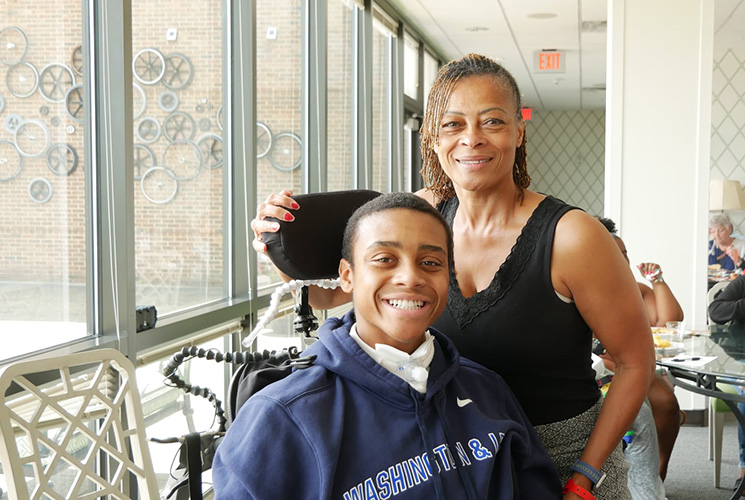
Preparing for Trach and Ventilator Use at Home
At Shepherd Center, patients on ventilators begin wheelchair mobility as early as the patient can tolerate. Before leaving Shepherd, patients take part in community outings to help them become comfortable using their equipment outside the center and in a community environment.
Shepherd Center clinicians also train each patient and their family members in home care techniques and health management. You and your loved one will receive detailed information educating them about the process at home.
For some of our patients on a ventilator, an implanted diaphragmatic pacemaker, or Diaphragm Pacing System (DPS), is an option for respiratory support.
Patient TestimonialI’m so incredibly thankful for Shepherd Center. This place has changed my life in so many positive ways. I know for a fact that if I hadn’t come here, I wouldn’t be off a ventilator. And I wouldn’t be pushing myself so far physically. They do everything they can to make you as independent as possible.
Reagan MartinC4 Spinal Cord Injury
Frequently Asked Questions
A ventilator is a machine that supports or recreates the process of breathing by pumping air into the lungs.
Because the spinal cord and brain help control breathing, people with a spinal cord and/or brain injury may require a ventilator. The ventilator assists breathing by helping the diaphragm, abdominal, and rib muscles move to allow air in and out of the lungs. Helping these muscles also provides the body with the ability to cough and move mucus out of the lungs and throat.
The nature of a person’s breathing problems will depend on the level of injury and the person’s general physical condition.
A ventilator works by pushing air into the lungs via a face/nasal mask (noninvasive ventilation) or trach tube (invasive ventilation).
The length of time an individual is on a ventilator varies greatly from patient to patient. Your care team will monitor your ability to breathe unassisted and wean you off the ventilator if your lungs function properly on their own.
The goal of ventilator weaning is to have the patient breathe on their own. Ventilator weaning is a gradual process that is coordinated by our lung specialists, who first determine the patient’s readiness. There are many factors at play such as respiration, cardiovascular health, psychological readiness, and decreased lung volumes that complicate or delay the ability for a patient to successfully be weaned.
If the patient meets a specific criteria for ventilator weaning, we gradually reduce their dependence on the ventilator and the patient begins to take on more of the work to breathe.
Additional Resources for Ventilator Management
As a leader in rehabilitative care for traumatic brain injury, spinal cord injury, and neurological conditions, Shepherd Center offers specialized information on innovative medical research and treatments. You can visit MyShepherdConnection, our online source for educational materials, to learn more about our respiratory services.

